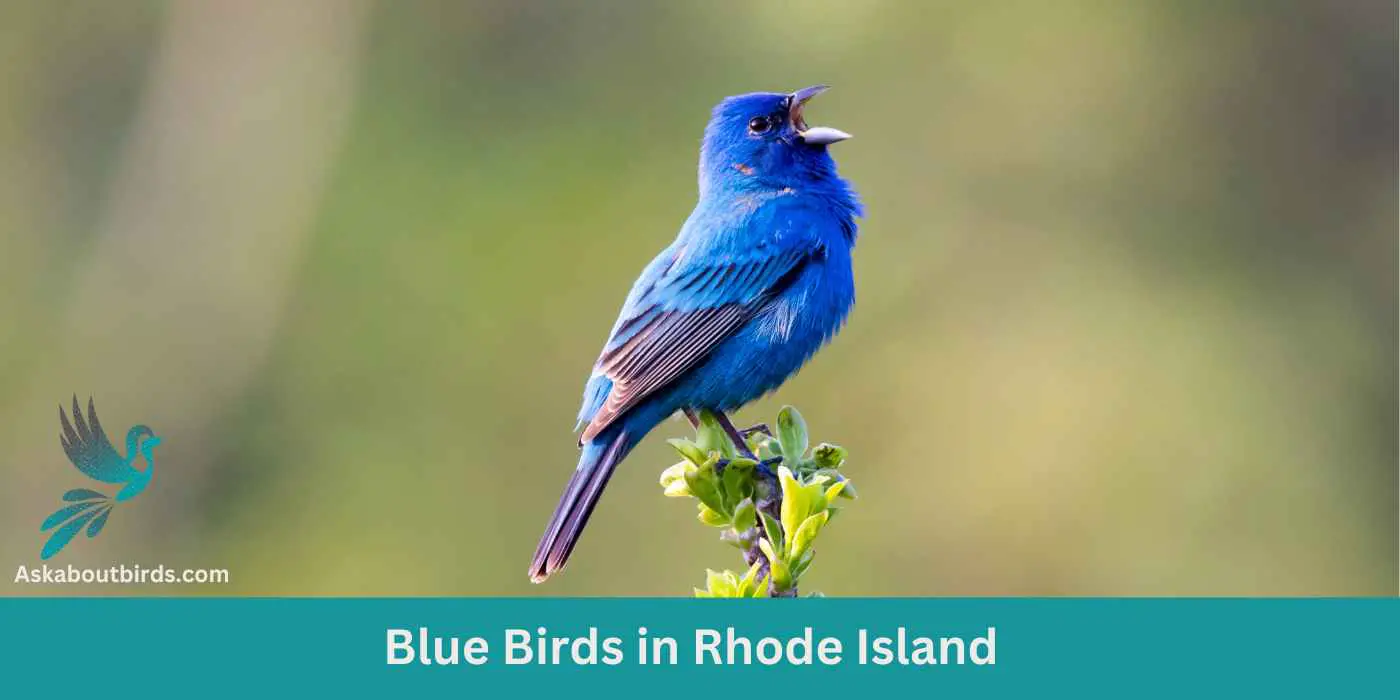Welcome to the smallest state with a big birding heart! Despite its size, Rhode Island is home to an array of beautiful blue birds that have made this state a must-visit destination for bird watchers around the globe.
Our FREE photo guide will be your companion as you explore the forests, coasts, and wetlands of this charming state, assisting you in identifying and appreciating the various beautiful blue feathers and hued native birds that call Rhode Island home. So grab your binoculars, download your guide, and let’s embark on a journey filled with blue skies and even bluer birds!
Blue Birds Found In Rhode Island
Despite its diminutive size, Rhode Island offers a surprisingly diverse range of habitats that attract a wide variety of birds. Its extensive coastline provides ample nesting and feeding grounds for shorebirds, while the inland forests and wetlands serve as home to many species of migratory and resident birds.
The state’s location along the Atlantic Flyway, a major migratory route, means that many birds pass through Rhode Island during their seasonal migrations, adding to the state’s already diverse avian population.
Eastern Bluebird
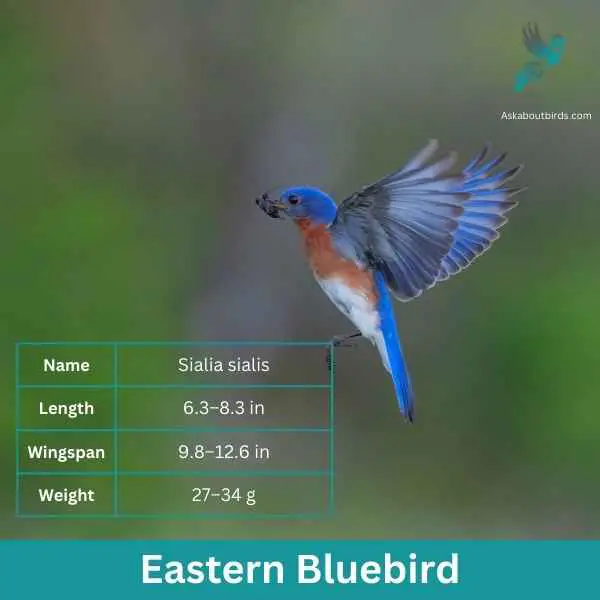
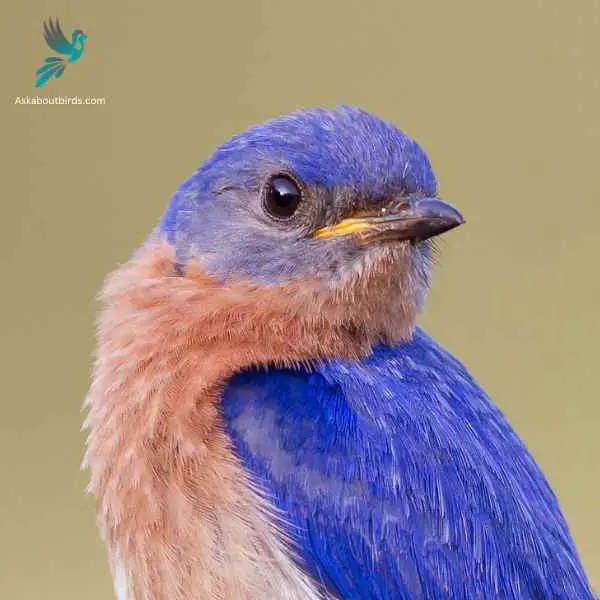
| Feature | Measurement |
|---|---|
| Scientific Name | Sialia sialis |
| Length | 6.3–8.3 in |
| Wingspan | 9.8–12.6 in |
| Weight | 27–34 g |
The Eastern Bluebird (Sialia sialis) is a small thrush found in open woodlands, farmlands, and orchards, and is recognized for its vibrant blue and red coloration. Male Eastern Bluebirds are dazzling with bright blue upperparts and a rusty or brick-red throat and breast, while females, though less colorful, still offer a similar pattern. The bird is native to North America and is commonly seen east of the Rockies, from Canada to the Gulf States and southeastern Arizona to Nicaragua.
Eastern Bluebirds feed on insects, wild fruit and berries. They have a gentle nature and are often seen perched alone or in small groups in the open, scanning the ground for prey. They are cavity nesters and will use old woodpecker holes or birdhouses if they are the right size.
Indigo Bunting


| Feature | Measurement |
|---|---|
| Scientific Name | Passerina cyanea |
| Length | 4.5–5.1 in |
| Wingspan | 7.1–9.1 in |
| Weight | 11.2–21.4 g |
The Indigo Bunting is a strikingly vibrant songbird, often hailed for its brilliant blue plumage and melodic song that graces woodlands and meadows during the warmer months.
Appearance: Males are renowned for their bright indigo blue feathers, which can appear darker in certain lights. Females and juveniles, on the other hand, are brown with subtle hints of blue on their wings and tail. The species lacks the vibrant streaking or spotting commonly found in many other songbirds.
Diet: Indigo Buntings primarily subsist on seeds, especially during non-breeding seasons. During the breeding season, they also consume a variety of insects such as beetles, caterpillars, and spiders, providing essential protein for their growing chicks.
Reproduction: Indigo Buntings build their nests close to the ground in shrubs or low tree branches. These nests, crafted meticulously with grasses and other plant materials, cradle clutches of typically 3 to 4 eggs. After hatching, the young are fed by both parents until they’re ready to fledge.
Tree Swallow
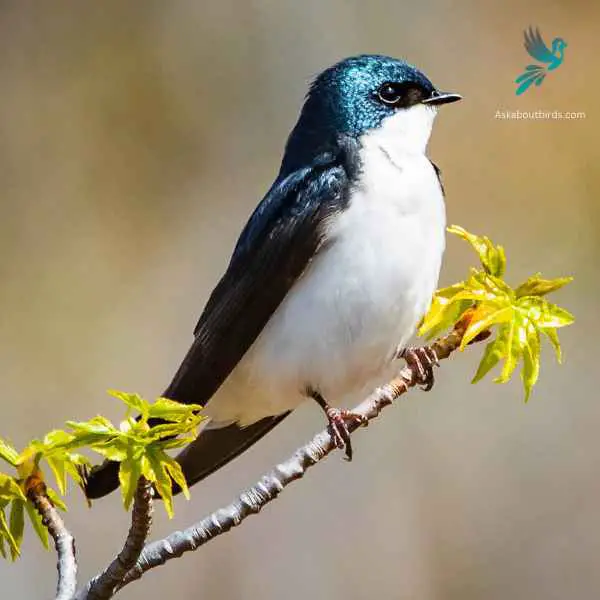
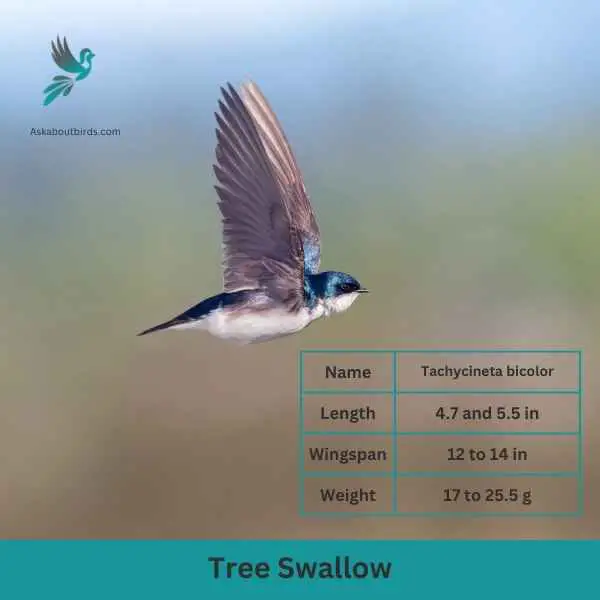
| Feature | Measurement |
|---|---|
| Scientific Name | Tachycineta bicolor |
| Length | 4.7 and 5.5 in |
| Wingspan | 12 to 14 in |
| Weight | 17 to 25.5 g |
The Tree Swallow is a graceful and agile bird, best recognized for its iridescent blue-green upperparts and sweeping flight patterns over open fields and water.
Appearance: The Tree Swallow is sleek with a streamlined body. The upperparts shine with a blue-green iridescence while the underparts are white. They possess long, pointed wings and a slightly forked tail, aiding in their agile flight.
Diet: Tree Swallows primarily feed on flying insects, skillfully catching them mid-air. During colder months when insects are scarce, they can switch to a diet of berries, particularly those of the bayberry, which other birds might find hard to digest.
Reproduction: Tree Swallows are cavity-nesters, typically choosing natural holes in trees or using bird boxes. They line their nests with feathers, creating a soft environment for the eggs. The female will lay a clutch of 4 to 7 white eggs.
Blue Jay
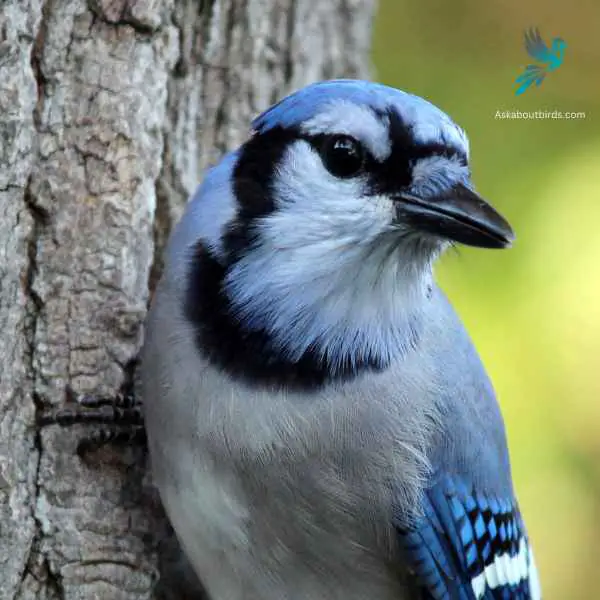
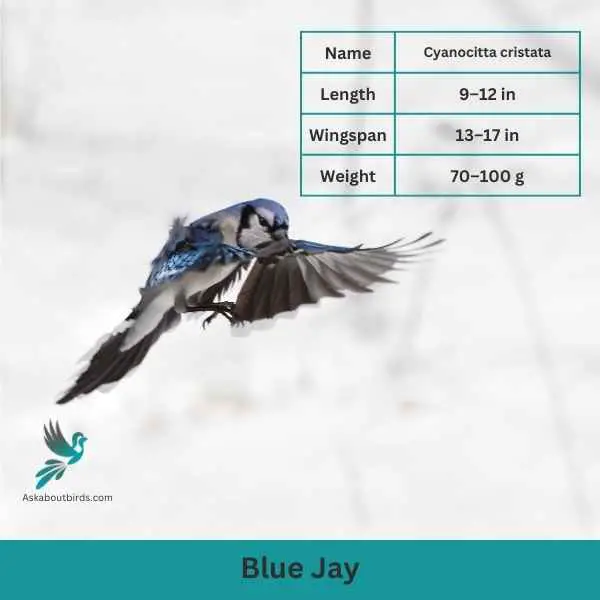
| Feature | Measurement |
|---|---|
| Scientific Name | Cyanocitta cristata |
| Length | 9–12 in |
| Wingspan | 13–17 in |
| Weight | 70–100 g |
The Blue Jay is a vibrant and easily recognized bird, known for its intelligence, distinctive calls, and bold behavior, commonly found throughout the eastern and central United States.
Appearance: The Blue Jay sports a striking blue upper body with white and black markings. Its face has a pronounced white patch with a black necklace that runs across the throat and around the head. The bird also features a pronounced blue crest, which can be raised or lowered, and its wings and tail are brightly colored with black bars and white tips.
Diet: Blue Jays are omnivores. Their diet consists primarily of seeds, nuts, especially acorns, fruits, and small insects. They’ve also been known to eat eggs or nestlings of other birds occasionally. Blue Jays often store food items in caches to eat later.
Reproduction: Blue Jays are monogamous birds that form long-lasting pair bonds. They typically build their nests in trees or large shrubs, constructing them from twigs, grass, and sometimes using mud as a binder. The female lays a clutch of 3 to 6 eggs, which are pale blue or sometimes white with brown speckles.
Belted Kingfisher

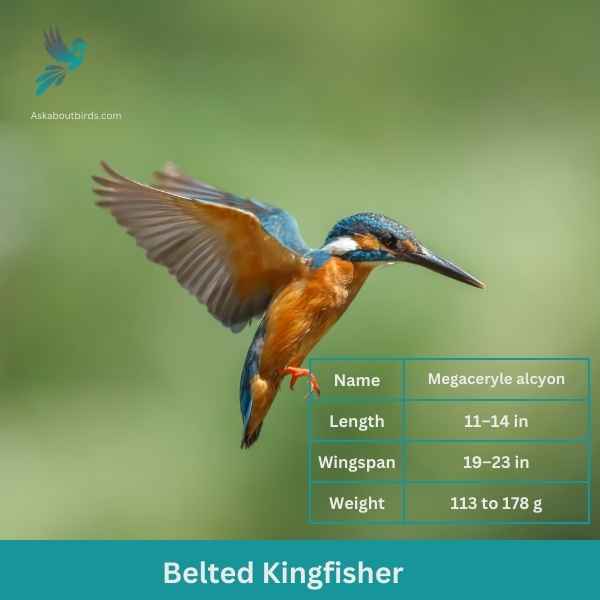
| Feature | Measurement |
|---|---|
| Scientific Name | Megaceryle alcyon |
| Length | 11–14 in |
| Wingspan | 19–23 in |
| Weight | 113 to 178 g |
The Belted Kingfisher is a distinctive and easily recognizable bird, frequently observed near water bodies, where it can be seen diving headfirst to catch prey.
Appearance: Sporting a prominent crest, the Belted Kingfisher has a slate blue-gray upper body and white underparts. Males possess a single blue band across their white chests, while females have an additional rufous band, making them one of the few bird species where females are more brightly colored than males. Their bill is long, sharp, and dagger-like.
Diet: As expert fishers, Belted Kingfishers mainly prey on small fish, but they’ll also consume crustaceans, insects, and amphibians. They’re known for their hunting tactic of hovering over water, spotting their prey, and then diving swiftly to snatch it.
Reproduction: Belted Kingfishers nest in burrows which they excavate in sandy or earthen banks, usually adjacent to water. The tunnel can be anywhere from 3 to 6 feet long, ending in a chamber. Within this chamber, the female lays a clutch of 5 to 8 white eggs.
Barn Swallow
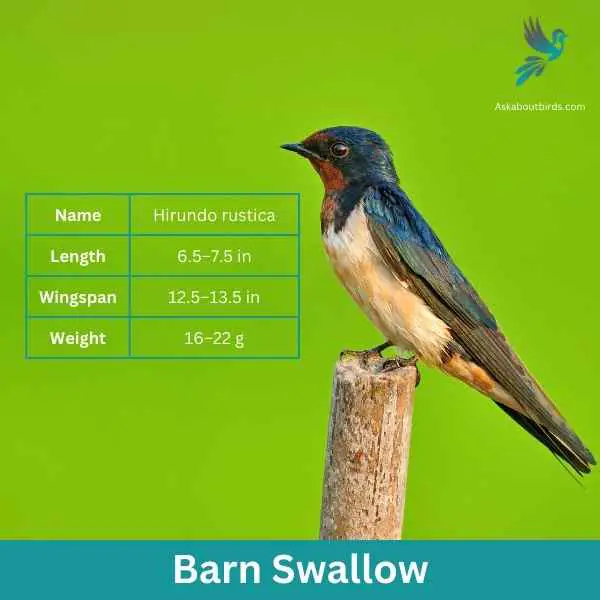

| Feature | Measurement |
|---|---|
| Scientific Name | Hirundo rustica |
| Length | 6.5–7.5 in |
| Wingspan | 12.5–13.5 in |
| Weight | 16–22 g |
The Barn Swallow is a sleek, agile bird renowned for its graceful flight patterns and iconic forked tail, often seen darting over fields and water bodies in search of flying insects.
Appearance: Barn Swallows have deep blue, almost iridescent, upperparts and a rufous to tawny underbelly. Their distinctively forked tail and long wings give them a streamlined look. Both males and females have a similar appearance, though males often exhibit slightly brighter colors and a deeper fork in the tail.
Diet: Barn Swallows feed primarily on flying insects, which they catch in mid-air during their agile and acrobatic flights. Their diet includes flies, beetles, moths, and other small flying insects.
Reproduction: Barn Swallows are known for building their mud nests on man-made structures, particularly barns, bridges, and eaves. The nest is cup-shaped and made from mud pellets, often lined with feathers. The female lays a clutch of 4 to 6 eggs.
Blue Grosbeak
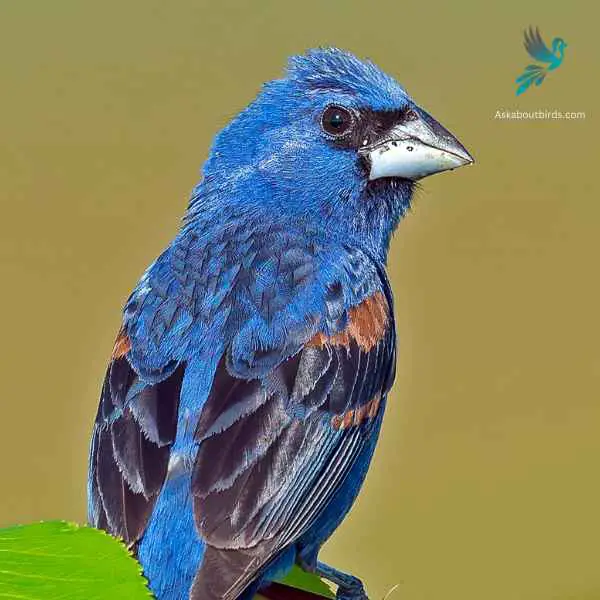
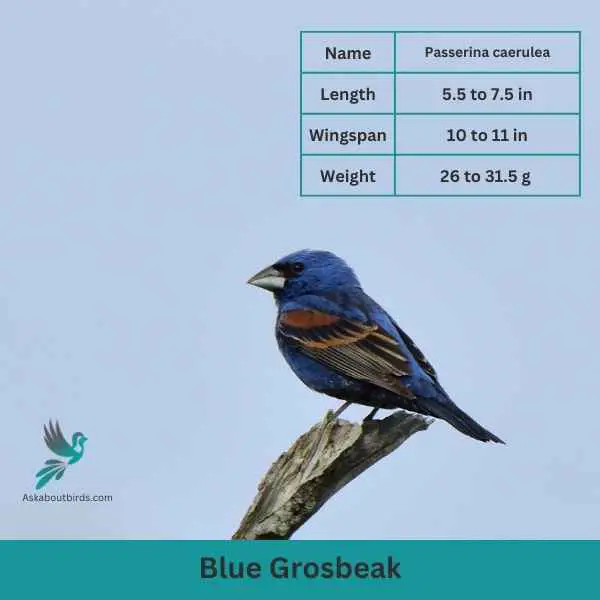
| Feature | Measurement |
|---|---|
| Scientific Name | Passerina caerulea |
| Length | 5.5 to 7.5 in |
| Wingspan | 10 to 11 in |
| Weight | 26 to 31.5 g |
The Blue Grosbeak is a medium-sized songbird found in North and Central America. The male Blue Grosbeak displays stunning plumage with deep blue feathers on its body and head, while the female has more subdued brownish tones. Both sexes have a thick, conical bill, which gives them their name “grosbeak,” meaning large beak.
These birds prefer open habitats such as grasslands, brushy areas, and woodland edges. Blue Grosbeaks are known for their melodious songs, which consist of a series of rich and varied notes. They primarily feed on seeds and insects, using their strong beaks to crack open seeds and forage on the ground or in low vegetation.
Blue-headed Vireo
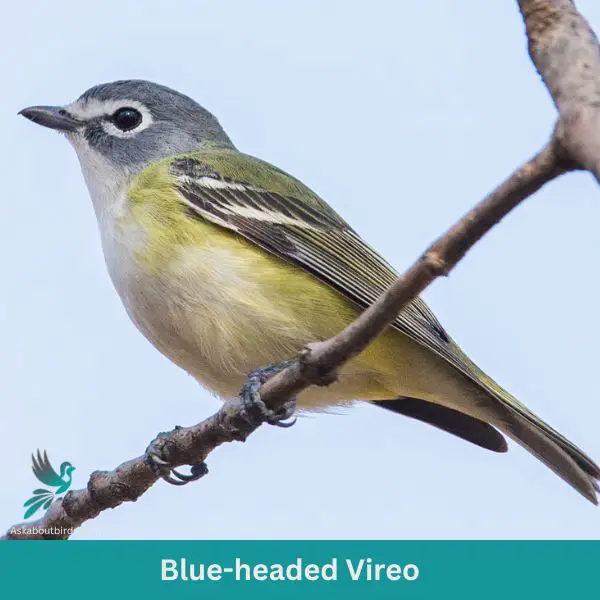
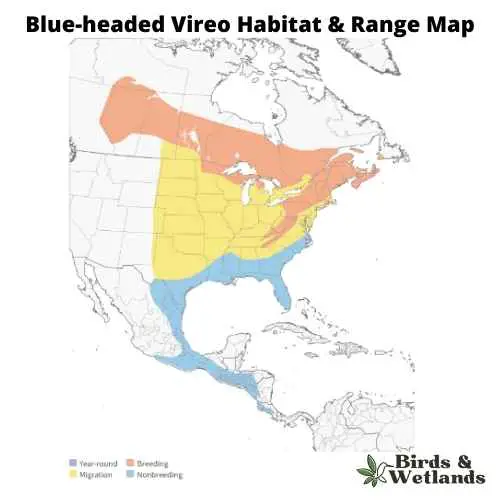
| Trait | Blue-headed Vireo |
|---|---|
| Scientific Name | Vireo solitarius |
| Length | 5-5.5 inches |
| Wingspan | 7.9-9.8 inches |
| Weight | 0.4-0.6 ounces |
The Blue-headed Vireo is a songbird recognized for its sharp and clear song as well as its distinct coloration.
Appearance: It has a blue-gray head and nape, contrasting sharply with its white throat and belly. A white eye ring combined with two white wing bars and yellowish flanks further accentuate its appearance.
Diet: The Blue-headed Vireo feeds mainly on insects and spiders. It often forages in the forest canopy, picking prey off leaves and twigs.
Reproduction: The female constructs a cup-shaped nest made of twigs, bark, and spiderwebs, often placed in the fork of a tree branch. Typically, she lays a clutch of 3-5 eggs. Both parents share the responsibility of incubating the eggs and feeding the chicks.
Blue-winged Warbler
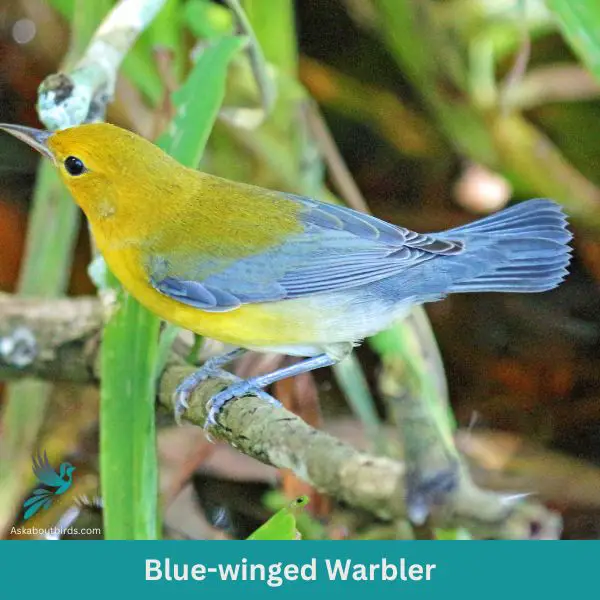
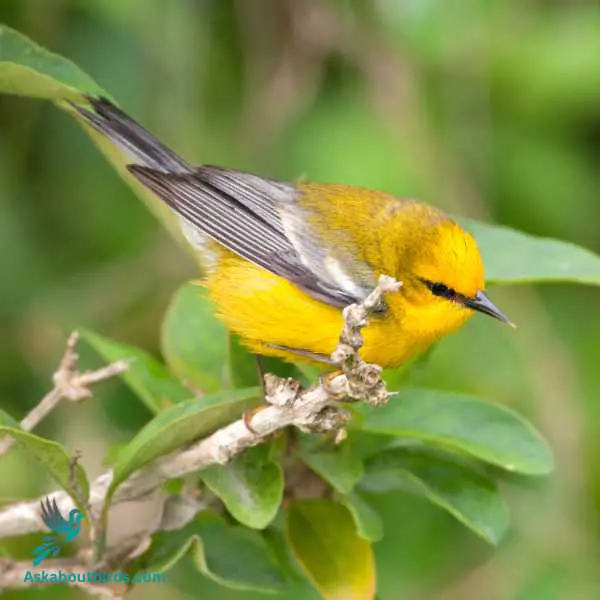
| Trait | Blue-winged Warbler |
|---|---|
| Scientific Name | Vermivora cyanoptera |
| Length | 4.3-4.7 inches |
| Wingspan | 6.7-7.5 inches |
| Weight | 0.3-0.4 ounces |
The Blue-winged Warbler is a vibrant songbird that stands out with its lemon-yellow coloring and buzzing song.
Appearance: This warbler displays a brilliant yellow body contrasted by blue-gray wings and a slim, black line through the eyes. The wings also feature two white wing bars.
Diet: The diet of the Blue-winged Warbler primarily consists of insects and spiders. They actively forage in shrubs and low trees, picking off their prey from the foliage.
Reproduction: Blue-winged Warblers build their nests on or near the ground, using grasses and other fine materials. The female lays a clutch of 4-6 eggs, which she incubates.
Cliff Swallow
Scientific Name: Petrochelidon pyrrhonota
Length: 5-6 in (13-15 cm)
Wingspan: 11-12 in (28-30 cm)
Weight: 0.7-1 oz (20-28 g)
The Cliff Swallow is a small, agile bird known for its characteristic mud nests, social behavior, and long-distance migrations.
Appearance: Cliff Swallows have a distinctive appearance with a dark blue back, a cream-colored forehead, an orange-brown rump, and a buffy or whitish underbelly. They also have a square or slightly notched tail.
Diet: The diet of Cliff Swallows primarily consists of flying insects, including flies, beetles, and wasps, which they catch in the air while flying.
Reproduction: Cliff Swallows are known for building gourd-shaped mud nests, often in colonies on vertical cliff faces, bridges, or buildings. The female typically lays a clutch of 3 to 6 white eggs. Both parents participate in incubating the eggs and feeding the chicks.
Where to Spot Rhode Island’s Blue Birds
Rhode Island, though small, offers a rich diversity of habitats that are home to a myriad of bird species, including the beautiful blue birds. Here are some top locations in the state known for their bird-watching opportunities:
- Sachuest Point National Wildlife Refuge: This refuge in Middletown is a haven for bird watchers. It boasts a diverse population of birds due to its varied habitats of shrubland, grassland, and coastal areas. During winter, it becomes a primary wintering area for the Harlequin Duck.
- Trustom Pond National Wildlife Refuge: Located in South Kingstown, this is the only undeveloped coastal pond in the state. It offers a variety of habitats, making it home to over 300 bird species including the Osprey and the American Black Duck.
- Ninigret National Wildlife Refuge: Situated in Charlestown, this refuge features salt and freshwater marshes, kettle ponds, and forested areas that attract a diverse range of bird species including migratory shorebirds and songbirds.
- Block Island National Wildlife Refuge: Located 12 miles off the southern coast of Rhode Island, Block Island is a stopover point for many migratory birds on the Atlantic Flyway. It is home to the threatened Piping Plover and the endangered Roseate Tern.
- Beavertail State Park: This park in Jamestown offers stunning ocean views and is a great spot to see migratory birds, especially during the fall and spring migrations. Hawks, falcons, and ospreys are commonly spotted here.
| Neighboring StatesBest Spots for blue Birds | |
|---|---|
| Massachusetts’s Blue Birds | 1. Parker River National Wildlife Refuge 2. Plum Island 3. Wompatuck State Park |
| Connecticut’s Blue Birds | 1. Hammonasset Beach State Park 2. Sherwood Island State Park 3. White Memorial Conservation Center |
FAQs on Blue Bird Species Found in Rhode Island
What are the characteristics of a Purple Martin?
The Purple Martin (Progne subis) is the largest swallow in North America. Adult males have dark, iridescent feathers that appear purple or blue in the sunlight, while females and juveniles have a more subdued coloration, with a grayish-brown upper body and a white belly. Purple Martins are aerial insectivores, meaning they catch insects while flying. They are social birds that nest in colonies, often in nest boxes provided by humans. They migrate to Central and South America for the winter.
What is the natural habitat of the Blue-gray Gnatcatcher?
The Blue-gray Gnatcatcher is a small bird found in North America. It inhabits a wide range of habitats, including deciduous forests, mixed woodlands, and shrublands. They are little backyard birds that are particularly fond of areas with scattered trees and thick shrubbery. In the northern cardinal eastern United States, they can be found in the deciduous forests, while in the western regions, they inhabit in large flocks of other habitats like riparian woodlands and chaparral.
How can I attract American Goldfinch and other birds to my backyard?
American Goldfinches (Spinus tristis) are attracted to backyards that provide their favorite foods and a safe environment. To attract them and other species of birds, set up bird feeders with their favorite foods like sunflower seeds, dandelion seeds, and thistle. They prefer tube feeders with small perches or platform feeders. Planting native plants that produce seeds they enjoy, such as sunflowers, dandelions, and thistles, will also help attract them. When attracting birds provides a clean water source for drinking and bathing in a platform feeder.
What are the differences between the Red-breasted Nuthatch and the White-breasted Nuthatch?
The Red-breasted Nuthatch (Sitta canadensis) and the White-breasted Nuthatch (Sitta carolinensis) are two different species of nuthatches found in North America. The Red-breasted Nuthatch has a rust-colored belly, a black cap on its head, and a black stripe through its eyes. The White-breasted Nuthatch has a white face and dark gray belly, a black or gray cap, and no eye stripe. Both species have a habit of walking head-first down tree trunks, but their preferred habitats differ. White-breasted Nuthatches prefer deciduous forests, while Red-breasted Nuthatches prefer coniferous forests.

